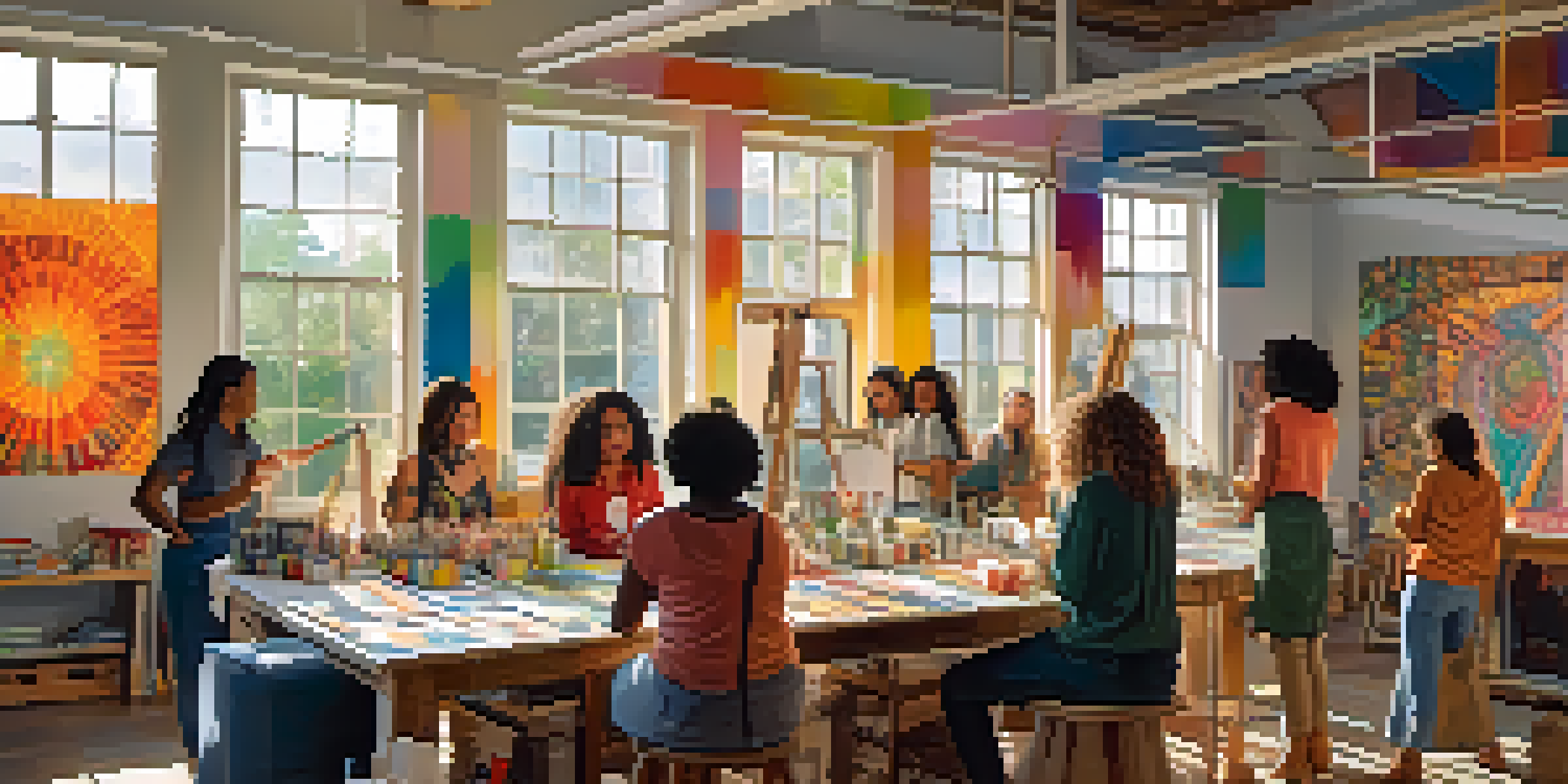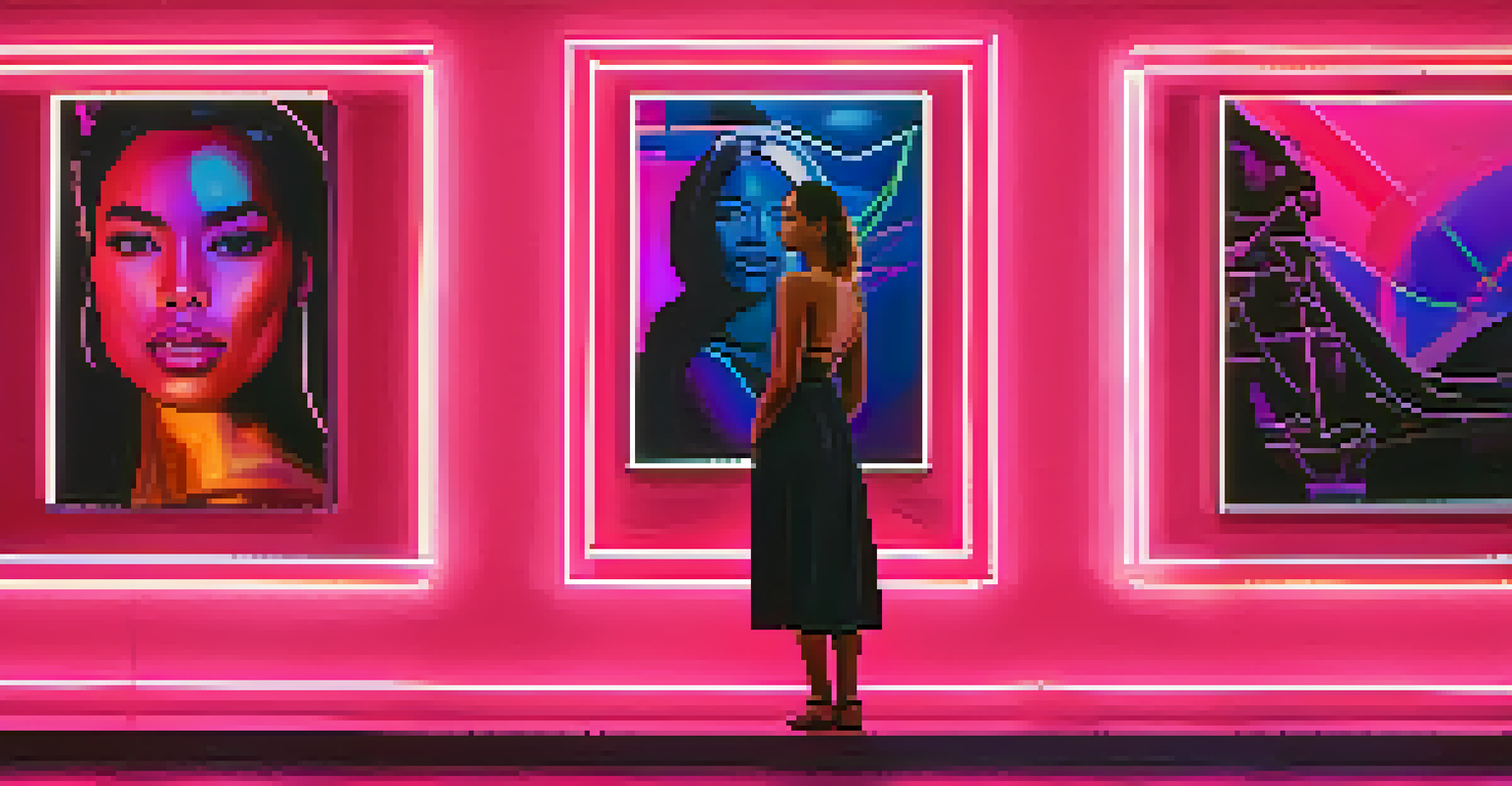Women Artists and Feminism: A Contemporary Perspective

The Historical Context of Women Artists and Feminism
To understand the contemporary landscape of women artists, we must first explore the historical context. For centuries, women have been marginalized in the arts, often overshadowed by their male counterparts. This exclusion has roots in societal norms that relegated women to the private sphere, limiting their opportunities for expression and recognition.
Art is not a mirror held up to reality, but a hammer with which to shape it.
Feminism emerged as a response to these inequities, advocating for women's rights not just in society but also in the arts. Movements in the 20th century, such as the Women's Liberation Movement, played a pivotal role in bringing attention to female artists and their contributions. Artists like Judy Chicago and the Guerrilla Girls became icons of this movement, using their work to challenge the status quo.
Today, as we reflect on this history, it’s clear that the fight for recognition and equality is ongoing. Understanding this context helps us appreciate the struggles and triumphs of women artists who have paved the way for future generations.
Contemporary Feminism and Its Influence on Art
Contemporary feminism has evolved to embrace a broader spectrum of identities and experiences, influencing how art is created and perceived. Today's artists often explore themes of gender, race, and sexuality, reflecting the complexities of modern society. This intersectional approach allows for a richer dialogue within the art world, urging audiences to engage with diverse narratives.

For example, artists like Kehinde Wiley and Frida Kahlo have reshaped how we understand identity through their powerful imagery. Their work not only challenges traditional representations but also celebrates the richness of cultural heritage. This shift in perspective invites a more inclusive appreciation of art that resonates with a wider audience.
Historical Marginalization of Women
Women artists have historically been marginalized, leading to a fight for recognition that continues today.
As feminism continues to intersect with various social movements, artists are increasingly using their platforms to advocate for change. This activism is evident in exhibitions, performances, and digital art that address pressing issues like climate change, body positivity, and systemic discrimination.
The Role of Social Media in Amplifying Women Artists
Social media has become a revolutionary tool for women artists to showcase their work and connect with audiences globally. Platforms like Instagram and TikTok allow artists to share their creations instantly, bypassing traditional gatekeepers in the art world. This democratization of art has empowered many female creators to gain visibility and build their own brands.
I am my own muse, the subject I know best. The subject I want to better.
Through hashtags like #WomenArtists and #FeministArt, artists can amplify their voices and connect with like-minded individuals. This sense of community fosters collaboration and support, creating a space where women's art can thrive. Additionally, social media facilitates discussions around feminist themes, allowing artists to engage directly with their audience.
However, this visibility also comes with challenges, such as online harassment and the pressure to maintain a curated image. Despite these hurdles, the benefits of social media in creating a platform for women artists are undeniable, opening doors to new opportunities and connections.
Art Collectives and Collaborative Projects
Art collectives have emerged as vital spaces for women artists to collaborate and express their shared experiences. These groups often focus on feminist themes, providing a supportive environment that fosters creativity and innovation. By working together, artists can amplify their individual voices while addressing collective issues faced by women in the art world.
One notable example is the 'Lesbian Art Project,' which brought together women artists from diverse backgrounds to explore themes of identity and sexuality. Such initiatives not only challenge mainstream narratives but also create a sense of belonging among participants. This collaborative spirit encourages experimentation and pushes the boundaries of traditional art forms.
Social Media Empowers Women Artists
Social media platforms have democratized access to art, allowing women artists to gain visibility and connect with audiences.
Furthermore, these collectives often engage with their communities, hosting workshops and exhibitions that invite public participation. This grassroots approach not only raises awareness about women's issues but also empowers local artists, creating a ripple effect of inspiration and support.
Intersectionality in Contemporary Women’s Art
Intersectionality plays a crucial role in the work of contemporary women artists, allowing them to address multiple layers of identity and oppression. By considering factors such as race, class, and sexuality, artists can create more nuanced and impactful narratives. This approach challenges the notion of a singular feminist experience, highlighting the diversity within the movement.
For instance, artists like Zanele Muholi and Yoko Ono explore themes of race and gender in their work, pushing boundaries and sparking important conversations. Their art not only reflects their personal experiences but also resonates with broader societal issues, inviting viewers to engage with complex realities.
As the dialogue around intersectionality continues to evolve, it challenges both artists and audiences to reconsider their perspectives. This shift encourages a more inclusive and empathetic understanding of the diverse experiences that shape women's art today.
Challenges Faced by Women Artists Today
Despite the progress made in recent years, women artists still face significant challenges in the art world. Issues such as gender bias, pay inequality, and lack of representation in galleries and museums continue to persist. These barriers can hinder the careers of talented female artists, making it difficult for them to gain recognition and financial stability.
Moreover, the pressure to conform to societal expectations can also affect how women create and present their work. Many female artists feel compelled to address feminist themes or fit into specific categories, which can stifle their creativity. This expectation can create internal conflict as they navigate their identities and artistic expressions.
Intersectionality Shapes Artistic Voices
Contemporary women artists are increasingly using intersectionality to address diverse identities and experiences in their work.
Advocacy and support networks are essential in addressing these challenges. By raising awareness and pushing for systemic changes, the art community can create a more equitable environment for women artists to thrive.
The Future of Women Artists and Feminism
Looking ahead, the future of women artists and feminism appears promising yet complex. As societal attitudes continue to evolve, women artists are poised to play a crucial role in shaping cultural narratives. This new generation of creatives is increasingly vocal about their experiences and challenges, using their art to provoke thought and inspire change.
The rise of technology, particularly in digital art and NFTs, presents new opportunities for women artists to explore innovative mediums and reach global audiences. This shift not only expands the possibilities for artistic expression but also creates new avenues for financial independence and visibility.

As we move forward, it’s essential to support and uplift women artists from all backgrounds. By fostering inclusivity and encouraging diverse voices, we can ensure that the art world reflects the richness of human experience and continues to challenge societal norms.